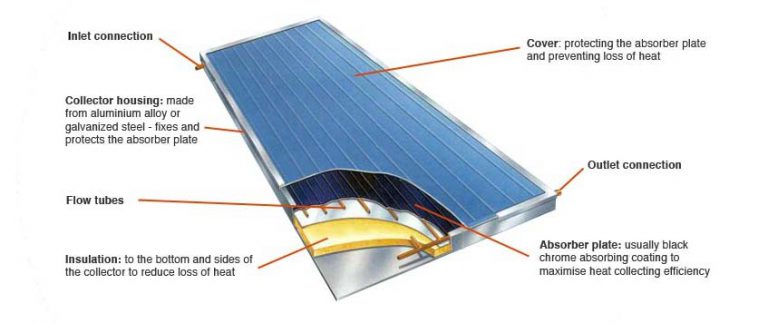SWH COLLECTORS
FPC (Flat Plate Collector)

A solar flat plate collector typically consists of a large heat absorbing plate, usually a large sheet of copper or aluminium as they are both good conductors of heat, which is painted or chemically etched black to absorb as much solar radiation as possible for maximum efficiency. This blackened heat absorbing surface has several parallel copper pipes or tubes called risers, running lengthways across the plate which contain the heat transfer fluid, typically water.
These copper pipes are bonded, soldered or brazed directly to the absorber plate to ensure maximum surface contact and heat transfer. Sunlight heats the absorbing surface which increases in temperature. As the plate gets hotter this heat is conducted through the risers and absorbed by the fluid flowing inside the copper pipes which is then used by the household.
The pipes and absorber plate are enclosed in an insulated metal or wooden box with a sheet of glazing material, either glass or plastic on the front to protect the enclosed absorber plate and create an insulating air space. This glazing material does not absorb the suns thermal energy to any significant extent and therefore most of the incoming radiation is received by the blackened absorber.
The air gap between the plate and glazing material traps this heat preventing it from escaping back into the atmosphere. As the absorber plate warms up, it transfers heat to the fluid within the collector but it also loses heat to its surroundings. To minimize this loss of heat, the bottom and sides of a flat plate collector are insulated with high-temperature rigid foam or aluminum foil insulation as shown
ETC (Evacuated Tube Collector)
The Evacuated tube collector consists of a number of rows of parallel transparent glass tubes connected to a header pipe and which are used in place of the blackened heat absorbing plate we saw in the previous flat plate collector. These glass tubes are cylindrical in shape. Therefore, the angle of the sunlight is always perpendicular to the heat absorbing tubes which enables these collectors to perform well even when sunlight is low such as when it is early in the morning or late in the afternoon, or when shaded by clouds. Evacuated tube collectors are particularly useful in areas with cold, cloudy wintry weathers.
So how do solar evacuated tube collectors work?. Evacuated tube collectors are made up of a single or multiple rows of parallel, transparent glass tubes supported on a frame. Each individual tube varies in diameter from between 1″ (25mm) to 3″ (75mm) and between 5′ (1500mm) to 8′ (2400mm) in length depending upon the manufacturer. Each tube consists of a thick glass outer tube and a thinner glass inner tube, (called a “twin-glass tube”) or a “thermos-flask tube” which is covered with a special coating that absorbs solar energy but inhibits heat loss. The tubes are made of borosilicate or soda lime glass, which is strong, resistant to high temperatures and has a high transmittance for solar irradiation.
Unlike flat panel collectors, evacuated tube collectors do not heat the water directly within the tubes. Instead, air is removed or evacuated from the space between the two tubes, forming a vacuum (hence the name evacuated tubes). This vacuum acts as an insulator reducing any heat loss significantly to the surrounding atmosphere either through convection or radiation making the collector much more efficient than the internal insulating that flat plate collectors have to offer. With the assistance of this vacuum, evacuated tube collectors generally produce higher fluid temperatures than they’re flat plate counterparts so may become very hot in summer.


